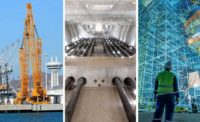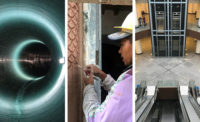All new Antarctic structures, including Halley VI, are required to minimize environmental impact. Vacuum flush and drainage systems, similar to those found on ships and airplanes, help cut water usage by 50%, compared to the previous station's system. This tactic saves energy since all water used on the station is created by melting ice, a process which consumes fuel. Custom-made sewage treatment plants, also based on those used in ships, produces clean-water discharge via a membrane bioreactor and UV disinfection. Dry sludge is incinerated, and heat is captured and fed into the energy systems. The station's simplified processes require 10 fewer maintenance staff to operate. In all, the project uses 26% less fuel than the previous base.
The R65 cladding is formed by 230-millimeter-thick, closed-cell polyisocyanurate foam insulation ensconced between glass-fiber-reinforced plastic panels. Station residents requested ample windows, so designers borrowed designs from the aerospace industry. In the two-story social module, a large double-glazed window is filled with a translucent nano-aerogel to minimize heat transfer and maximize light in the summer. Other areas incorporated triple-glazed windows with plastic spacers between each pane.
Hospitality-like interior details provide a pleasant environment. "We imagined a day in the life of a scientist, from the moment their feet hit the carpet in the bedroom until the moment they go back to bed again," Broughton says. Lighting and colors were specially designed to overcome seasonal affective disorder during the months of 24-hour darkness. Even some of the wood veneers were specifically selected to overcome the sensory deprivation of Antarctica. “We chose Lebanese cedar veneer because it’s the only one that gives off a pleasant aroma,” he adds.
In some ways, the project resembles a machine more than a building. "Although expensive, it's a bit like a Formula One race car, where the innovation can feed down into the wider industry, especially over time and through mass production," Broughton says.
Project Team
Owner: British Antarctic Survey, Cambridge, England
Lead Design Engineer: AECOM, London
Architect: Hugh Broughton Architects, London
General Contractor: Galliford Try, Uxbridge, England












Post a comment to this article
Report Abusive Comment